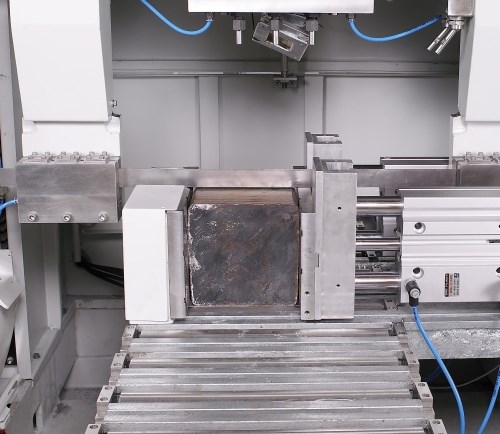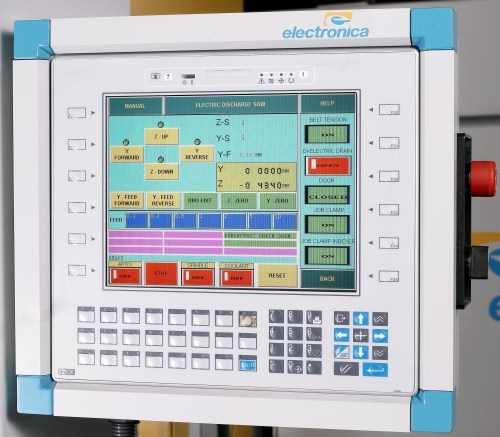Electrical Discharge Saw Slices Through Hard Alloys
Electrical discharge sawing uses spark-erosion technology and is said to create blanks from exotic alloys as much as 70 percent faster than wire EDM.
Sawing and wire EDM are two processes shops commonly use to cut workpiece blanks from material stock. In some cases, very high material hardness precludes the use of a band saw for blank cutoff. Although wire EDM is an alternative for such materials, it can be a time-consuming operation that creates a production bottleneck.
India’s Electronica Machine Tools has developed a cutoff process it says can quickly create blanks from titanium, nickel, metal composites and other conductive materials regardless of their hardness. The Electrical Discharge Sawing machine (EDS) uses spark-erosion technology that can cut through exotic alloys as much as 70 percent faster than wire EDM, according to Stephen Ross, vice president of Ross Group Technologies. In addition, Mr. Ross says the cutting width is only 0.06 inch and the heat affected zone that is generated is less than 0.019 inch.
An EDS machine functions similarly to a wire EDM unit. However, instead of using wire as the electrode, the EDS machine uses a thin, electrically charged band of mild steel that continually rotates around two pulleys. Cutoff begins as the rotating band is lowered to the workpiece and non-toxic sodium silicate dielectric is sprayed across the band and workpiece. The resulting spark-erosion “sawing” process cuts at an average speed of 2.5 square inches per minute. The key for this fast speed lies in the machine’s proprietary electronics, Mr. Ross says. In comparative test cuts of a dense, metal composite measuring 6.25 inches in diameter, EDM cut time was approximately 4 hours, while EDS cut the material in only 26.5 minutes.
Cuts can be performed on stock with round, straight or angled surfaces. Because the band does not wander during the operation, it creates very straight cuts. This minimizes material waste, thus reducing costs. The spark-erosion operation creates very little sawing force, so a simple pneumatic clamping system is used to secure material for cutting. A programmable stock infeed system automatically advances stock after cuts are completed.
Mr. Ross says the overall operating cost of an EDS machine is low. For example, the EDS uses electricity at a rate of only $4.00 per hour. In addition, each band costs approximately $1.40 (a strip butt welder is provided with each EDS machine to allow users to create their own bands). Unlike the wire consumed in an EDM process, a single steel band is used for multiple cuts. For instance, a band can perform four cuts before replacement when cutting stock measuring 2.5 inches in diameter. Band replacement is said to take less than 2 minutes.
The EDS is available in North America in two sizes to accommodate stock with cross sections ranging in size from 7.87 x 7.87 inches to 12 x 12 inches. Each version has an enclosed work area, an integrated fume extraction system and a dielectric reclamation system. A touchscreen control allows easy programming and offers automatic program generation for standard material shapes.
Related Content
-
Inside an Amish-Owned Family Machine Shop
Modern Machine Shop took an exclusive behind-the-scenes tour of an Amish-owned machine shop, where advanced machining technologies work alongside old-world traditions.
-
Choosing Your Carbide Grade: A Guide
Without an international standard for designating carbide grades or application ranges, users must rely on relative judgments and background knowledge for success.
-
Threading On A Lathe
The right choices in tooling and technique can optimize the thread turning process.
.jpg;maxWidth=970;quality=90)
.jpg;width=70;height=70;mode=crop)











.jpg;maxWidth=300;quality=90)






.jpg;maxWidth=970;quality=90)